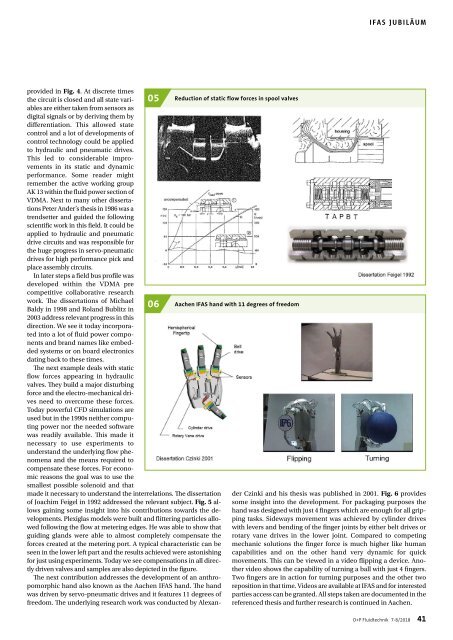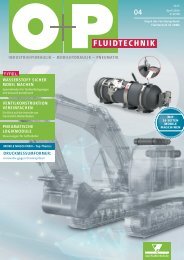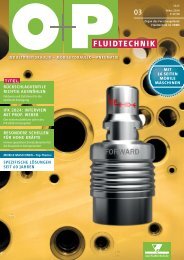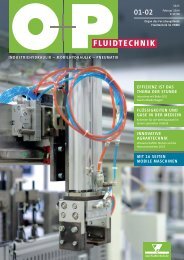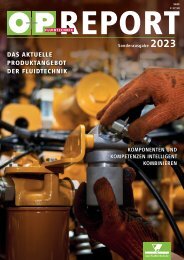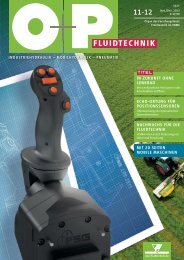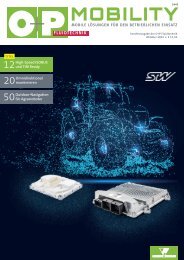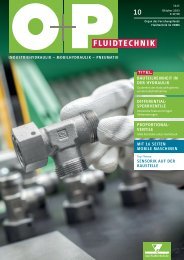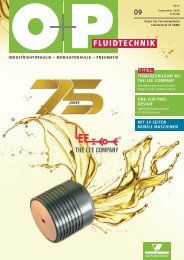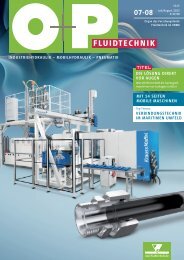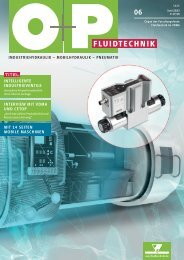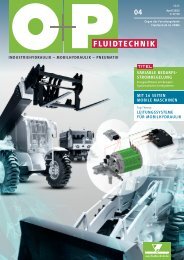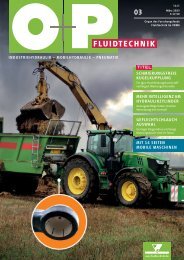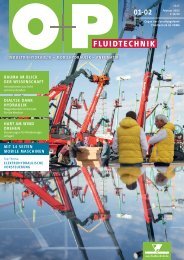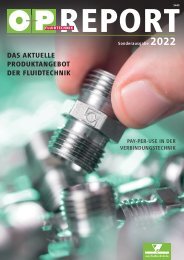O+P Fluidtechnik 7-8/2018
O+P Fluidtechnik 7-8/2018
O+P Fluidtechnik 7-8/2018
- TAGS
- fluidtechnik
Sie wollen auch ein ePaper? Erhöhen Sie die Reichweite Ihrer Titel.
YUMPU macht aus Druck-PDFs automatisch weboptimierte ePaper, die Google liebt.
IFAS JUBILÄUM<br />
Reduction of static flow forces in spool valves<br />
Aachen IFAS hand with 11 degrees of freedom<br />
provided in Fig. 4. At discrete times<br />
the circuit is closed and all state variables<br />
are either taken from sensors as<br />
05<br />
digital signals or by deriving them by<br />
differentiation. This allowed state<br />
control and a lot of developments of<br />
control technology could be applied<br />
to hydraulic and pneumatic drives.<br />
This led to considerable improvements<br />
in its static and dynamic<br />
performance. Some reader might<br />
remember the active working group<br />
AK 13 within the fluid power section of<br />
VDMA. Next to many other dissertations<br />
Peter Ander’s thesis in 1986 was a<br />
trendsetter and guided the following<br />
scientific work in this field. It could be<br />
applied to hydraulic and pneumatic<br />
drive circuits and was responsible for<br />
the huge progress in servo-pneumatic<br />
drives for high performance pick and<br />
place assembly circuits.<br />
In later steps a field bus profile was<br />
developed within the VDMA pre<br />
competitive collaborative research<br />
work. The dissertations of Michael<br />
06<br />
Baldy in 1998 and Roland Bublitz in<br />
2003 address relevant progress in this<br />
direction. We see it today incorporated<br />
into a lot of fluid power components<br />
and brand names like embedded<br />
systems or on board electronics<br />
dating back to these times.<br />
The next example deals with static<br />
flow forces appearing in hydraulic<br />
valves. They build a major disturbing<br />
force and the electro-mechanical drives<br />
need to overcome these forces.<br />
Today powerful CFD simulations are<br />
used but in the 1990s neither computing<br />
power nor the needed software<br />
was readily available. This made it<br />
necessary to use experiments to<br />
understand the underlying flow phenomena<br />
and the means required to<br />
compensate these forces. For economic<br />
reasons the goal was to use the<br />
smallest possible solenoid and that<br />
made it necessary to understand the interrelations. The dissertation<br />
of Joachim Feigel in 1992 addressed the relevant subject. Fig. 5 allows<br />
gaining some insight into his contributions towards the developments.<br />
Plexiglas models were built and flittering particles allowed<br />
following the flow at metering edges. He was able to show that<br />
guiding glands were able to almost completely compensate the<br />
forces created at the metering port. A typical characteristic can be<br />
seen in the lower left part and the results achieved were astonishing<br />
for just using experiments. Today we see compensations in all directly<br />
driven valves and samples are also depicted in the figure.<br />
The next contribution addresses the development of an anthropomorphic<br />
hand also known as the Aachen IFAS hand. The hand<br />
was driven by servo-pneumatic drives and it features 11 degrees of<br />
freedom. The underlying research work was conducted by Alexander<br />
Czinki and his thesis was published in 2001. Fig. 6 provides<br />
some insight into the development. For packaging purposes the<br />
hand was designed with just 4 fingers which are enough for all gripping<br />
tasks. Sideways movement was achieved by cylinder drives<br />
with levers and bending of the finger joints by either belt drives or<br />
rotary vane drives in the lower joint. Compared to competing<br />
mechanic solutions the finger force is much higher like human<br />
capabilities and on the other hand very dynamic for quick<br />
movements. This can be viewed in a video flipping a device. Another<br />
video shows the capability of turning a ball with just 4 fingers.<br />
Two fingers are in action for turning purposes and the other two<br />
reposition in that time. Videos are available at IFAS and for interested<br />
parties access can be granted. All steps taken are documented in the<br />
referenced thesis and further research is continued in Aachen.<br />
<strong>O+P</strong> <strong>Fluidtechnik</strong> 7-8/<strong>2018</strong> 41


